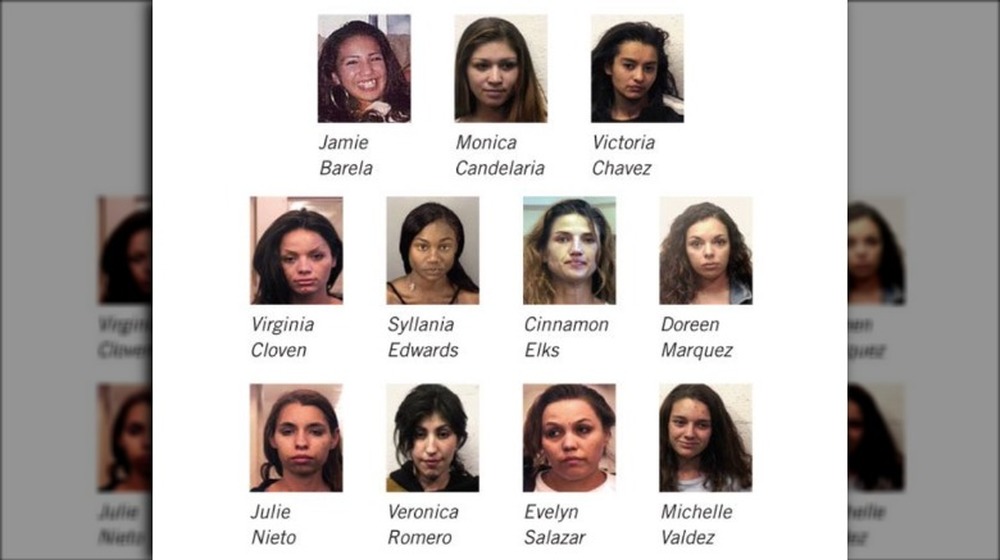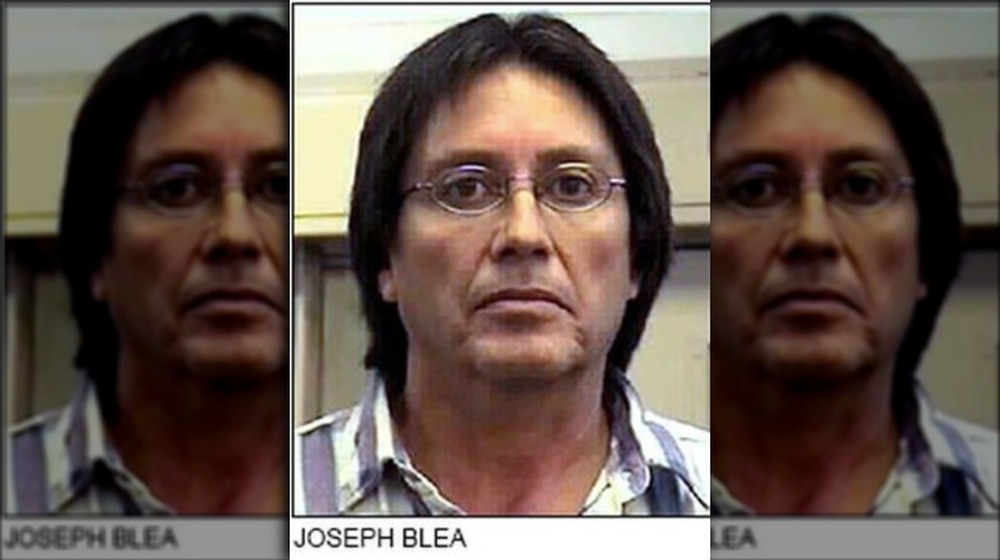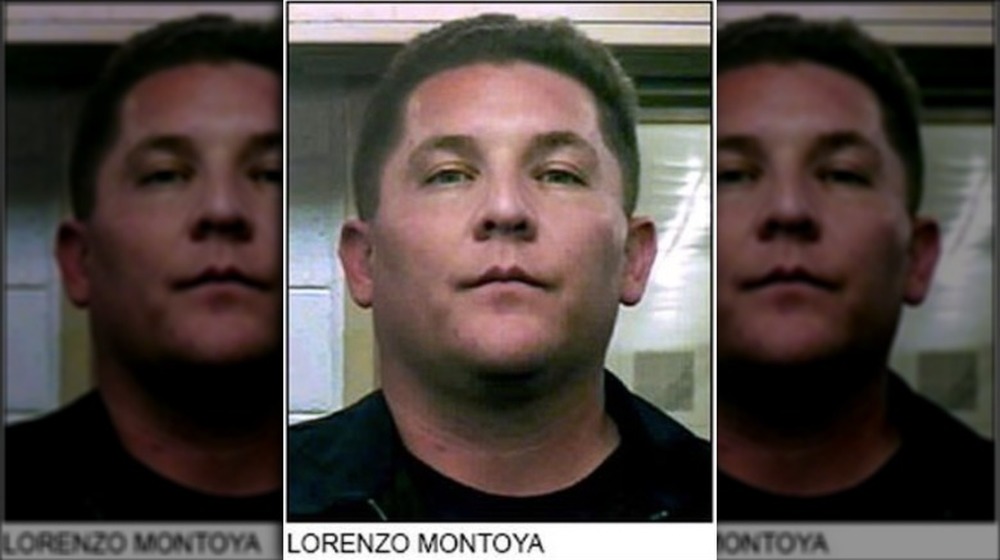The Untold Truth Of The West Mesa Murders
An unsolved murder case has haunted the city of Albuquerque, New Mexico for more than a decade. According to the Albuquerque Journal, it all began when a woman out for a walk with her dog in a part of the city known as the West Mesa made a grisly discovery in February 2009. What appeared to be a human bone was just the beginning. After authorities unearthed the remains of 11 women and one unborn child, they feared the worst: They were dealing with the city's first serial killer.
Dubbed the West Mesa Murders, they sparked a frenzy of investigations, interrogations, and media attention, but despite the best efforts of police to bring whoever was responsible to justice, the crimes remain unsolved to this day. Still, authorities have not given up. The acting lieutenant of the Albuquerque Police Department's Violent Crime Division, Holly Anderson, told KOAT Action News in February 2021 that police are still working the case, despite not having any new evidence to go on in recent years. She said that people should not lose hope, that there is no statute of limitations on crimes like these, and that the police will work the West Mesa Murders until the case is solved.
The West Mesa Murder victims
According to the Albuquerque Police Department, something didn't sit right with Christine Ross when her dog Ruca found a bone on their walk in the West Mesa. So she took a picture of it and texted her sister. Being a registered nurse, she was able to tell Christine that the bone looked like a human femur, so Christine contacted the police.
Within a year, they had identified all of the 11 victims, which ranged in age from 15 to 32. All went missing between 2003 and 2005. One of the victims, 22-year-old Michelle Valdez, had been pregnant when she was killed, and the bones of her unborn child were also found among the victims. All of the women, except 15-year-old Jamie Barela, had one thing in common: They were all involved in drugs and sex work. All of the women were Latina and all were from New Mexico, except Syllannia Edwards, who was African American and from Oklahoma.
Police have offered a $100,000 reward for anyone offering evidence leading to the discovery of the person the media came to call the West Mesa Bone Collector. Although they have had several suspects, two of whom seemed to fit the description quite well, they have yet to find compelling evidence to close the case.
Joseph Blea called the victims 'trashy'
One of those suspects was Joseph Blea. According to the Albuquerque Journal, Blea was no stranger to the parts of the city where sex work is known to take place. He had actually had over 100 encounters with police in the two decades preceding the discovery of the West Mesa murder victims. In one incident years before the West Mesa murders, police searched his car after a woman said he had exposed himself to her. They found rope and electrical tape during the search. Blea's wife and daughter claimed to have found jewelry and female underwear that didn't belong to them in their home, and police confirmed this after they searched his home eight months into the West Mesa investigation.
In 2015, Blea was found guilty of sexual assault in charges stemming from incidents in the 1980s and 1990s and was sentenced to 90 years in prison. Despite the jewelry, underwear, and other evidence that appeared to connect him to the case — including the testimony of a former cellmate who said that Blea claimed to have known and hired the West Mesa victims and called them "trashy" — police have still been unable to conclusively tie him to the murders.
Lorenzo Montoya was killed while possibly in the act
Like Blea, police also knew Lorenzo Montoya to be violent and hire sex workers in Albuquerque's East Central corridor. They had picked him up in 1998 when he offered an undercover cop $40 for sex. They arrested him again a year later as he raped and strangled a sex worker that he apparently never had any plans to pay, since he only had $2 in his wallet at the time. The process repeated itself in more or less the same way about five years later.
Police had also received a report of domestic violence from Montoya's girlfriend, who claimed he beat her and did "gross things" to her that she didn't want to elaborate on in the report. She also told them that he threatened "to kill me and bury me in lime."
That threat and the circumstances of his death led police to suspect that Montoya had been the West Mesa Bone Collector. According to Albuquerque's KQRE, Montoya hired a sex worker in December 2006 and took her to his home located less than two miles away from the site where the West Mesa victims were buried. He choked her to death, and when the woman's boyfriend/pimp came looking for her, he shot and killed Montoya. Although the murders stopped after that, police have unfortunately not been able to say without a doubt that Montoya was the serial killer known as the West Mesa Bone Collector.
Connection to interstate sex trafficking ring
Authorities believe that the women may have been involved in a large interstate sex trafficking operation. According to the El Paso Times, the presence of Syllannia Edwards among the victims has led authorities to believe that sex trafficking gangs could have been involved. Edwards was from Oklahoma, but was known to have been in Texas and Colorado before ending up in Albuquerque. It is unknown, however, if she traveled on her own or was trafficked there. Several arrests and convictions in El Paso, Texas, indicated that Albuquerque is part of a broader sex trafficking route that includes the states of Nevada, Colorado, New Mexico, and Texas, as well as the Mexican city of Juarez.
According to New Mexico State University, the FBI has investigated long-haul truck drivers as suspects in murders of sex workers along major highways, and authorities have reason to believe that Edwards was one such victim. The El Paso Crime Stoppers office received an anonymous tip in 2010 that a suspect whose last name was Cota had killed a girl nicknamed "Mimi" and "Chocolate," both of which were names Edwards was known to go by. Despite the tip, however, the West Mesa Murder case remains unsolved.
Keeping Albuquerque's sex workers safe
In 1999, a sex worker named Cynthia Vigil Jaramillo was kidnapped and imprisoned in a city south of Albuquerque by a man named David Parker Ray, aka the "Toy-Box Killer." In the preceding decades he had tortured and killed around 40 other women, and Jaramillo knows her fate would have been the same had she not escaped. She alerted the police, and Ray was arrested. According to A&E, Jaramillo and a woman named Christine Barber founded an organization to protect sex workers in New Mexico after the discovery of the West Mesa victims in 2009. They founded Safe Streets New Mexico in response to the threats sex workers face in the state and the lack of attention paid to violent crimes against them.
Female sex workers are far more likely to be the victims of violent crimes like rape and murder, but communities do not tend to take notice of such cases in the same way as when women from other parts of society are affected. For example, the case of serial killer Ted Bundy, who killed 36 women in Washington state in the 1970s, received loads of media attention, and Bundy's name is well-known. However, in the proceeding decades, a man named Gary Ridgway killed almost 50 women, most of them sex workers, but the case of the "Green River Killer" received much less attention. With Safe Streets New Mexico, Jaramillo and Barber aim to give women from this vulnerable sector the protection society fails to provide them.





